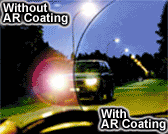Anti-Reflective Coating
An Anti-Reflective (A/R) Coating also referred to as an Anti-Glare coating is a microscopic thin but extremely hard layer applied to the surface of the lens through a vacuum coating technology. A/R coatings are primarily used to help with glare from fluorescent lights and other man made lights that may cause reflections on untreated lenses. Some of the most notable characteristics include the reduction of glare from car headlights, street lights, computer monitors, and other light base. Below you will find information related to the cause of reflections, composition of A/R Coatings, purpose, types of A/R coatings, tinting with A/R coatings, and the maintenance of A/R coatings
Cause of reflections
- The difference in refractive index between air and raw transparent materials (including spectacle lenses) causes reflections on both sides of the lenses.
- Anti-Reflective coatings are based on the application of destructive interference layers to the surface of lenses that disrupt the reflective wave paths.
- Usually 90% to 92% of light is transmitted through uncoated lenses, depriving the eyes of 8% to 10% of light, which deprives contrast and visual acuity of their full potential. A/R coatings allow at least 99% of light to pass through the lens increasing contrast, hence visual acuity.
- The stray light from uncoated lenses may create ghost images on the outside and inside of the lenses. The outside reflection is usually a reflective image of whatever is facing the lenses. The inside reflection is usually of the eye and may include objects behind the wearer. When viewing on coming car lights, street light star burst light effect may appear around the light source.
Composition of A/R Coatings
- Most Anti-Reflective coatings consist of at least one if not a combination of the following: Magnesium Fluoride (MgF2) (Mainly used on glass), Silicone Oxide (SiO2), Titanium Oxide, Zirconium Oxides, and with technological advances other oxides and chemical that are not listed may be used
- A/R is a microscopic thin but extremely hard layer applied to the surface of the lens through a vacuum coating technology.
Purpose of A/R Coatings
- A/R is known to improve contrast hence visual acuity by reducing the loss of stray light and reducing reflections.
- A/R coatings are primarily used to help with glare from fluorescent lights and other man made lights.
- Some of the most notable characteristics include the reduction of glare from car headlights, street lights, computer monitors, and other light base.
- The AR coating material has a lower refractive index than the actual lens material, which creates the anti-reflective effect.
- A/R coatings are usually applied to both front and back of lenses. However, on sunglasses A/R coatings are only applied to the backside of the lenses to eliminate any reflection from behind or a mirror image from the eye.
- Since the object of sunglass lenses is to filter light and reflect light away, an Anti-Reflective coating is not advisable to the front side of the lens, which would allow light to pass through easier.
Types of A/R Coatings
- There are many types of anti-reflective coatings available. The cost efficient coatings will still serve the purpose of reducing glare and allow 99% of light to pass through the lens, but these coatings require more attention to maintain lenses clean from smudges, streaks and water spots
- Premium (hydrophobic) A/R coatings (Crizal, Vivex, Teflon, Etc.) offer an added layer of scratch protection and a slick surface that repels dirt, smudges and water spots.
- Premium AR coatings are more durable to scratches than regular conventional coatings and usually cost more for the technology required to offer this durability and non-glare performanc
- If a tint is desired, lenses must be tinted prior to applying an anti-reflective coating. Some Premium A/R coatings require a hard coat that may not be tintable. The application of A/R coatings will lighten tints; most opticals and labs usually consider this when processing orders
Maintaining A/R Coatings
-
Anti-Reflecive coatings should be cleaned with specially formulated lens cleaners. Other commonly used home made solution include:
- A mild soap (no higher than PH 7.5) diluted in water.
- 70% isopropyl alcohol diluted in water (no more than 50/50 mix if used on a regular basis)
- Stay away from strong detergent soaps and strong acidic or base solutions (PH's ranging around 10) including any ammonia based solutions like Windex or other industrial cleaners.
World Optic
Phone: +1 714-871-2020
cash, check, credit card, invoice, paypal
$00 - $000
2443 E. Chapman Ave.
Fullerton, CA 92831
 World Optic
+1 714-871-2020
2443 E. Chapman Ave., Fullerton, CA
World Optic
+1 714-871-2020
2443 E. Chapman Ave., Fullerton, CA
$00 - $000
4.5 out of
5 stars -
272 votes


